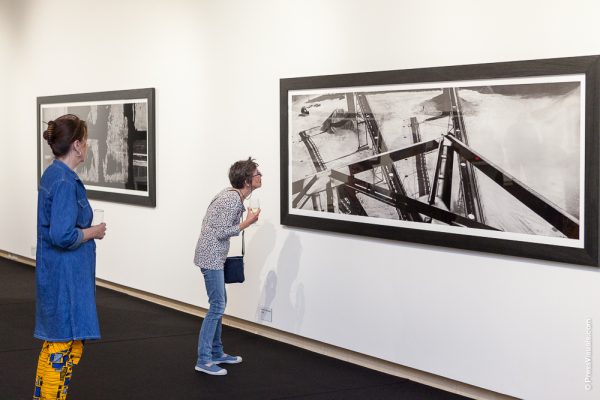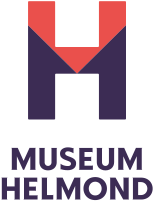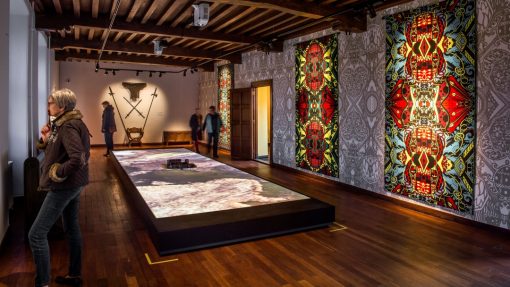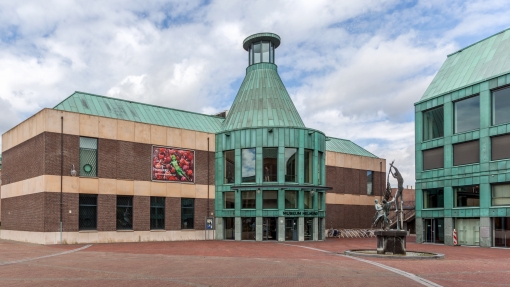
- 16 October 2018
- 27 January 2019
- Kasteel Helmond
Josef Koudelka
Industrial landscapes
From 16 October 2018 to 27 January 2019, Helmond Museum will present an extraordinary exhibition on the works of legendary photographer Josef Koudelka in the Kunsthal Helmond gallery. The exhibition will feature a selection of 35 of Koudelka’s best iconic industrial landscape photographs taken over the past three decades in Europe, the United States, and South America.
The exhibition, Josef Koudelka / Industries, features extraordinary panoramic photos in black and white photos that span nearly three metres in length. At first glance, they look like huge graphic illustrations, but take a closer look and you’ll see they are indeed photographs, the images abstracted in a dark room to create a powerful and timeless image.
Vast spaces
Koudelka draws on his skills as a photographer to capture vast spaces. His landscapes seem to materialize from the photograph and suck us into their depths. We become aware of the devastating effect of industry on the landscape while enjoying the beautiful depictions and the way Koudelka plays with shapes and forms. We even smile at times at Koudelka’s bizarre humour, presented through his choice of subject, viewpoint, or visual framing.

CZECH REPUBLIC. Black Triangle region (Ore Mountains). 1993. The limit of a coal-mine.
Invasion of Prague
Josef Koudelka, éminence grise of engaging photography, will celebrate his eightieth birthday this year and will also exhibit his now-legendary images of the Soviet invasion of Prague, which took place exactly fifty years ago. This photo series launched the Czechoslovakia-born Koudelka into instant stardom in 1968, but also made him a political refugee.
Magnum
Despite having worked and trained as an aeronautical engineer, Koudelka decided to focus fully on photography at the age of 29. He photographed the theatre and gypsy life. After his photo series on the invasion of Czechoslovakia by Warsaw Pact troops gained him international acclaim, and after receiving the 1969 Robert Capa Gold Medal, Koudelka decided to remain abroad for his own safety. After Great Britain rejected his asylum application, he remained stateless until he was granted French citizenship in 1987. In the meantime, he became a member of the prestigious Magnum photo agency, he exhibited at important locations, and he gained critical acclaim with his photographic book Gitans (Gypsies) in 1975.
Panoramic photos
For Koudelka, absolute freedom is a must in his work. This is why he rarely works on commission and leads a Spartan existence that requires very little money. One exception is his participation in the DATAR project, for which twenty photographers were asked to capture the French landscape. Koudelka chose Paris and the northern region of France as his inspiration. This was the first time he had used a panoramic camera. The subject and the camera so impressed him that they continued to work with them for the next thirty years. Given the expense of the panoramic medium, Koudelka was forced to find a way to pay for his materials. He therefore took on assignments that granted him absolute artistic freedom. He had two conditions: he would only photograph locations of his own choosing and the factory or company that hired him could not use the photographs for commercial or advertising purposes. In 1990, when Czechoslovakia broke away from Russian influence, Koudelka returned to his homeland. There, he photographed the Black Triangle in Bohemia, the most polluted place in Central Europe. This border region shared by the Czech Republic, Germany, and Poland was devastated by sulphur dioxide emissions from brown coal combustion for electricity generation used to power heavy industry. Koudelka used an analogue panoramic camera until 2012. The availability of film and the printing options for his materials were starting to decline. In that same year, Leica converted his camera into an ultra-light definition format. His landscape photos were featured in acclaimed photo books like Black Triangle (1994), Chaos (1999), and Industries (2017).

Acclaim
Koudelka published several extraordinary photo books, including Exiles (1988) and Wall (2012), about the wall constructed by Israel on the West Bank. Koudelka has received dozens of awards, including the Grand Prix de la Photografie (1987), the Henri Cartier-Bresson Award (1992), and the Cornell Capa Infinity Award (2004). In 2013, he was named Commandeur de l’Ordre des Arts et des Lettres by the French Ministry of Culture after receiving the Czech medal of honour in 2002. Koudelka lives alternately in Paris and Prague.
Fondazione MAST
The exhibition was created by photography curator François Hébel for the biennial Photo/Industria 2017 in Bologna, under the auspices of Fondazione MAST. This is the first time this exhibition is being held outside Bologna. The exhibition was created in collaboration with Magnum Photos Paris.




